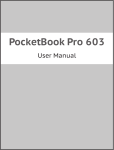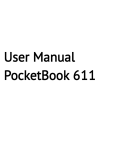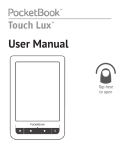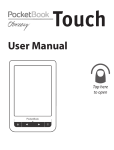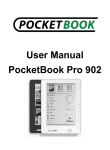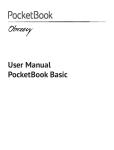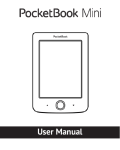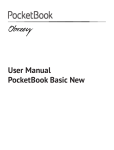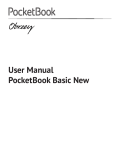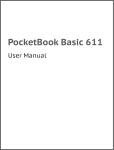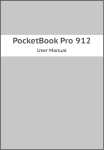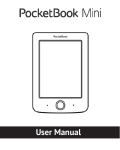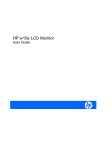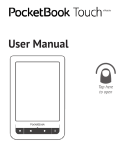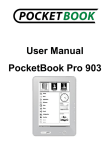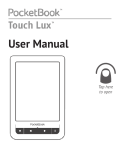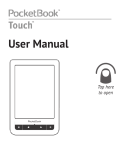Download User Manual PocketBook Pro 602
Transcript
PocketBook Pro 602 User Manual Table of Contents SAFETY PRECAUTIONS.......................................... 4 APPEARANCE..........................................................10 Front View 10 Back View 12 TECHNICAL CHARACTERISTICS........................14 GET TING STARTED...............................................15 Charging Battery 15 Turning On 16 Modes of Device Operation 17 Loading Files 18 Navigation19 Working with On-Screen Keyboard 20 MAIN MENU.............................................................22 Main panel 23 TTTTTTTTTTTTTTTTT 2 Widgets24 Status Bar 28 Task List 29 READING BOOKS...................................................32 Library32 Library Renewal 37 Loading of the Protected Electronic Books (Adobe DRM) 37 Reading Mode 42 SOFTWARE..............................................................52 Favorites52 Notes52 Applications53 Dictionary57 Music58 Photo60 Search61 TTTTTTTTTTTTTTTTT 3 NETWORK CONNECTIONS..................................63 Bluetooth64 Configuring Wi-Fi Connection 70 Closing Network Connections 72 CONFIGURATION...................................................73 FIRMWARE UPDATE..............................................83 TROUBLESHOOTING............................................87 CUSTOMER SUPPORT..........................................90 COMPLIANCE WITH INTERNATIONAL STANDARDS............................................................91 Safety Precautions Before start working with the Device, please, read this section carefully. Following these instructions will help you ensure your safety and extend service life of the Device. Storage, Carriage and Usage Conditions Device operating temperature range is 0°С to 40°С, so don’t expose the Device to excessively high or low temperatures. Never leave cables near heat sources. Heated cables or their insulation may become deformed or damaged, which could lead to fire or electric shock. Try to avoid next impacts: • direct sunlight • direct flame or smoke (cigarette, lighter, open fire etc.) SSSSSSSSSSSSSSSSSS 5 • exposure to liquids or damp (do not use the Device in the rain, in the street at higher humidity, near bodies of water etc.) • penetration of liquids or moisture • exposure to strong electromagnetic fields, electrostatic charges and artificial sources of UV electromagnetic radiation • excessive mechanical pressure on the screen, connectors and keys of the Device. Do not leave the Device for a long time in poorly ventilated environment, e.g. in a car or in closed tight boxes/packaging. Neither drop nor try to bend the Device. Protect the screen from objects that may scratch or damage it. To ensure adequate protection of the screen, we recommend storing the Device in a protective and/or hard cover. SSSSSSSSSSSSSSSSSS 6 Keep away from children. Maintenance Do not disassemble or modify the book reader. Do not use the Device with a damaged battery, charger (broken case, poor contact, broken feed cable) or SD card. If the battery is damaged (cracked case, leakage of electrolyte, off-shape etc.) it should be replaced by the authorized personnel. Usage of home-made or modified batteries may cause an explosion and/or damage the Device. Do not use organic or inorganic solvents (e.g. benzoyl etc.) to clean the screen/case. Use a soft cloth to remove dust from the Device’s surface. Apply a few drops of distilled water to remove dirt. SSSSSSSSSSSSSSSSSS 7 Up to five faulty pixels are acceptable in the screen and do not constitute a warrantable defect of the screen. By the end of product guarantee term, please contact the nearest authorized service facility for examination on the subject of security is maintained. For detailed information about service centers in your region please visit the official website of PocketBook International: http://www.pocketbook-int. com. RF Safety The Device receives and transmits radio frequencies and may interfere with radio communications and other electronic equipment. If you use personal medical Devices (e.g. a pacemaker or hearing aid) please contact your doctor or the manufacturer to SSSSSSSSSSSSSSSSSS 8 learn whether or not such medical devices are protected against external RF signals. Do not use wireless communication in places where it is prohibited, e.g. onboard a plane and in hospitals – this may affect airborne avionics or medical equipment. Utilization Incorrect disposal of this Device may have adverse impacts on the environment and public health. To prevent such consequences follow the devicespecific disposal requirements. Recycling of these materials helps preserve natural resources. For more information regarding recycling issues please contact local municipal authorities, your domestic waste collection service, store where you purchased the Device, or the authorized service center. SSSSSSSSSSSSSSSSSS 9 Disposal of electric and electronic components (the Directive is applicable to the EU and other European countries where separate waste disposal systems exist). In other countries dispose batteries accordingly to local laws. Do not destroy the battery by burning it to avoid the danger of explosion! Appearance FRONT VIEW 1. 2. 3. 4. 5. 6. Screen Forward – turns page forward Backward – turns page backward Home – returns to Main Menu Menu – opens context menu Speakers – 2×0.5 W speakers AAAAAAAAAA 11 7. ОК – confirms selection 8. Up 9. Right navigation keys 10. Down 11. Left 12. Return – goes back to the previous menu 13. Reset button – restarts the Device 14. 3.5 mm audio jack 15. LED indicator – indicates the Device’s power mode. Flashing orange – charging, solid orange – charged, solid green – power consumption 16. Micro-USB port – designed for connecting your Device to either PC or charger (optional) via the micro-USB cable 17. Micro SD card slot – used to insert an external microSD memory card AAAAAAAAAA 11 BACK VIEW 18. On/Off – long press switches the Device on/ off, short one – opens express menu 19. Battery compartment cover button AAAAAAAAAA 11 NOTE You can configure key mapping to your own in Configuration > Key mapping. Technical Characteristics Display Processor RAM Internal Storage Operating system Communications 6’’ E Ink Vizplex™ 800×600, 166 dpi, black/white 533 МHz 256 МB 2 GiB Linux® Wi-Fi™ (b/g) Bluetooth™ 2.1 USB 2.0 (480 Mb/s) Memory slot microSD up to 32 GiB Audio output 3.5 mm stereo jack 2×0.5 W speakers Accelerometer Book formats Image formats Audio format Battery Dimensions Weight Yes PDF, EPUB (including DRM), PDF, EPUB, FB2, TXT, DJVU, RTF, HTML, CHM, DOC, TCR, FB2.ZIP, PRC, DOCX JPEG, BMP, PNG, TIFF MP3 Li-Polymer, 3.7 V, 1530 mAh 132×182×10.6 mm 250 g Getting Started IN THIS CHAPTER… You will learn how to prepare the Device to work and about main control features. CHARGING BATTERY To extend battery lifetime, it’s recommended to charge the Device for the first time from 8 to 12 hours in the off state. You can charge the battery from PC using USB-cable or from the power line using charger (optional). To charge the battery for the first time, do the following: 1. Connect the Device to a computer or charger with USB-cable. Indicator will start blinking orange as soon, as charging starts GGGGGGGGGGGGGGG 11 2. When the battery is fully charged, indicator turns solid orange. Now you can disconnect the Device and turn it on for the first use. If the Device is on when you connect the cable to PC, a dialog window asking to select action – PC link or Charge – will appear. Charge will start if corresponding mode selected only. TURNING ON To turn on the Device, press and hold On/Off button for a few seconds until startup logo will appear. When the Device is ready to operate, an image will be changed to Main menu or last opened book, depending on settings (Configuration > At startup, open). GGGGGGGGGGGGGGG 11 MODES OF DEVICE OPERATION Normal operating mode is the main mode of Device operation. Green light of indicator signalizes about power consumption (e.g. screen refresh, network connection or music playback). Sleep mode is the power-saving mode of operation. The Device actually switches off during user idle time to save battery charge. No power is required for E Ink screen to maintain a displayed image. Running applications are saved in RAM of the Device. Safe mode – service mode for Device load with manufacturer’s settings. To load the Device in this mode, hold the Home button while turning it on. GGGGGGGGGGGGGGG 11 LOADING FILES Connect the Device to the PC using micro-USB cable. NOTE The Device should be kept on while transferring files. You will be prompted to select USB mode PC Link or Charge either. Select PC Link. Operating system of computer will detect Device’s storage as removable disk (if SD card installed – as two ones). Now you can copy files to the Device or SD card using Explorer or other file manager. ATTENTION After copying files safely remove the Device before disconnect the cable! GGGGGGGGGGGGGGG 11 NAVIGATION Use navigation buttons Up, Down, Left, Right to select required item (e.g. book, media file, application, widget or menu item). Press OK button shortly to open selected. Continuous OK press opens item context menu (if available) Press Return button to return to the previous menu, Home button to return to Main menu. Continuous Return press opens short task list, short On/Off button press — full one. To open section’s menu, press Menu button. Also you can configure key mapping to your own in Configuration > Key mapping section. GGGGGGGGGGGGGGG 22 WORKING WITH ON - SCREEN KEYBOARD To navigate through the keyboard use the navigation keys and OK button. To speed up keyboard operations all symbols are divided into 5 zones. First pressing enables fast transfer to the middle of the selected zone, and then you can select the required symbol in this zone. GGGGGGGGGGGGGGG 22 1. Change text case 2. Erase last entered symbol 3. Change input language. To add the language to the onscreen keyboard layout go to Configuration > Keyboard. Main Menu IN THIS CHAPTER… You will learn about basic elements of user interface of the Device. Main menu contains main functional and control software elements (main panel and widgets) displayed after turning on and launching the Device (if the corresponding option in Configuration > At startup, open is selected). To access Main menu from other application, press Home button or press several times Back button. Appearance of Main menu can be changed in correspondent Configuration section. MMMMMMMMM 22 MAIN PANEL This Main menu section contains Device’s main software elements: • Library • Favorites • Notes • Applications • Dictionary • Photo • Music • Search • Configuration Detailed information about each Main Panel section see in Software section of the Manual. MMMMMMMMM 22 WIDGETS Widget is a brief view of a particular application. To bring up an application in full screen, open the widget as usual application. Context menu allows changing or configuring widget. Last opened books Displays recently opened books list. Number of displayed books depends on Main menu appearance settings. Widget settings allow toggle view between list and thumbnails. You cannot change this widget. Clock Digital or analog clock (toggles in widget context menu). Calendar MMMMMMMMM 22 Displays recent month calendar. In full-screen mode displays recent year calendar. Sudoku Quick launch of Sudoku – popular Japanese puzzle. Dictionary Opens Dictionary application Music player Displays current track and provides basic music playback control: play/pause, previous/next track. Calculator Simple calculator allows you to perform 4 arithmetic operations, calculate per cent, and take the square root. By pressing the button in the right bottom corner of the widget you can switch to fullscreen application Engineering Calculator (to see more in Applications). MMMMMMMMM 22 eBook Quick access to online bookstores. You can switch between stores in widget context menu. You can set up several stores in settings file eBook. cfg. This is a text file, located on internal Device storage in folder \system\config\widgets\eBook and containing widget parameters, separated by commas. Example: Bookland,bookland.bmp,http://bookland.net/go,1,1,1 Libri.de,libri.bmp,http://ers.libri.de/home,1,1,1 To change settings copy file eBook.cfg to PC and edit it with any text editor (e.g. Windows Notepad). Widget parameters are described below. MMMMMMMMM Parameter Name 22 Format Description Example String (up to 12 symbols) Displayed as widget title BookLand Logo file name string .bmp file should be located in folder \system\config\ widgets\eBook. The image should have resolution 235×205 Bookland.bmp Web-site address string Link to web page opens after widget activation http://bookland.net/go Serial number transfer flag 1 or 0 Sends Device serial number. Can be used by some stores for automatic log in 1 Device model transfer flag 1 or 0 Sends Device’s model and manufacturer info 1 Connection type transfer flag 1 or 0 Sends information about connection type (either Wi-Fi or 3G) 0 Store name MMMMMMMMM 22 After editing file, copy it to the internal Device storage to \system\config\widgets\eBook folder. PocketNews Launches PocketNews application (see Software > Applications > PocketNews). STATUS BAR Status bar is located at the bottom of the screen and displays next service information: • Date and time • Battery charge • – Wi-Fi is active • – Bluetooth is active • – Bluetooth headset is connected • – Music player is on. MMMMMMMMM 22 In reading mode date changes to information about book: current page number/total page count, book title and current read percentage. Battery charge and time are displayed always. NOTE In sleep mode, the clock is removed from the status bar to save power for screen update. TASK LIST Device software supports multitasking, and you can quickly switch between running applications in several ways: • by opening short task list with continuous Back button press • by calling extended Task list with short On/ Off button press. MMMMMMMMM 33 Except task switching, you can force close running applications: select an application, bring up context menu by pressing Menu button and select Delete task. Besides task management, you can also access quickly some Device control features: • – Lock keyboard. To unlock, touch key icon with stylus or press On/Off button • – Turn on/off Bluetooth • – Open wireless connections list • – Make screenshot. The images are saved in screens folder • – Open music player • – Switch off the Device. You can force close applications via extended Task list only, short task list doesn’t support this feature. NOTE Return to Main menu by pressing Home button doesn’t close application; it is still running in background. MMMMMMMMM 33 That causes, for example, that read percentage displayed in Library doesn’t change after you exit the book by pressing Home. To close application completely, press Back button. Reading Books IN THIS CHAPTER… You will learn how to use reading software, fill in your library and configure the Device for the most comfortable reading. LIBRARY Library is e-books file manager. To open a book, touch its title with stylus or select it using navigation keys and press OK. Library menu allows to filter, group, sort, change appearance of the section and perform search. RRRRRRRRRRRRR 33 Filtration criteria • All Books – all books on selected storage are displayed • Now reading – books were opened and read more than one page • Favorites. Grouping criteria Depending on selected grouping next parameters are displayed as folders’ titles: • Folder – real folder name • Author – an alphabet is added at the top of the screen • Series • Genre • Format. RRRRRRRRRRRRR 33 Sorting criteria • File names • Book titles • Last opened • Creation date • Series • Author Sorting can be ascending or descending. Books list views Simple – in this mode next information is displayed: • • • card) • Folder or file format icon Book title Location icon (if file is located on memory Status icons and read percentage: • Now reading RRRRRRRRRRRRR 33 • Read • Favorite Detailed – in this mode information about author and file size added Thumbnails – in this mode book cover, status icons and file size are displayed Storage-dependent appearance has three options: • Internal + memory card • Internal • Memory card. Information block at the bottom of the screen displays read books and storage status. RRRRRRRRRRRRR 33 Context menu allows proceeding with next file and folder operations: • Open (if item can be opened with alternative reader program – Open with…) • File – file operations • Rename • Move to folder • Delete • Add to/Remove from Favorites • Mark as read/unread • Send to… – send book via Bluetooth • Information – brief information about book/ folder. RRRRRRRRRRRRR 33 LIBRARY RENEWAL You can copy books into internal storage of the Device or to external SD-card like it described in Loading Files section, or download it directly from online bookstores. NOTE Books, downloaded from online bookstores are saved to root folder of internal storage of the Device. LOADING OF THE PROTECTED ELECTRONIC BOOKS (ADOBE DRM ) You must register on the www.adobe.com site to be able to use the book protected format (Sign in>Create an Adobe Account). RRRRRRRRRRRRR 33 Downloading Book Using the *.acsm Link 1. Visit the www.adobe.com site using a PC browser. NOTE The current browser version does not support Flash Player 2. Go the Products section 3. Follow the Digital Editions link in the alphabetical index of products 4. Open the Sample eBook library link at the bottom of the page to enter the library 5. Select the book and click Download item button 6. The file download window will appear on the screen. The file name with .acsm extension is indicated in the file name. Click Save button 7. The URLLink.acsm link will appear after saving on your PC NOTE The same sequence of actions also allows you to download a link to a protected book of any online book shop. RRRRRRRRRRRRR 33 Take the following actions to open a protected book (DRM) on your Device: 1. Copy the book link file (*.aсsm) to the Device. 2. Find and open this file on your Device. 3. Follow on-screen instructions to activate your Device. Use the on-screen keyboard to enter login and password of your account into the Device activation form at www.adobe.com to proceed. Then you will be able to download the book. 4. Download a book. The full version of the book will be available in the Digital Edition folder after download is completed. The downloaded book is protected with DRM and it cannot be opened by an unregistered user. RRRRRRRRRRRRR 44 Book downloading via PC 1. Open the Adobe Digital Editions application NOTE You will be prompted to activate new Device, when it’s connected to PC for the first time. If the Device is not activated, it will be impossible to copy a book from PC to Device using Adobe Digital Editions. If you have previously used registration data in a firmware version earlier than 2.0.4 in the Device for opening protected books then, when upgrading the software version, you will have to enter registration data of www.adobe.com once more to open such books again.The Adobe Digital Edition authorization can be deleted in the section Settings > Maintenance > Delete the ADE authorization. 2. Select the Go to library view icon 3. Click All items 4. Find the desired book and copy it to your Device. To open it, use your registration data at www. adobe.com. RRRRRRRRRRRRR 44 Book Borrowing A registered user can borrow a book from online bookstores (e.g. www.adobe.com). A borrowed book will be placed in the Borrowed books section of the user’s account and becomes available for reading. The book can be opened on a PC or the Device using the account data on the www.adobe.com site. Every time you open a book the Device will prompt you to return book. After the borrowing period or after reading the book completely it becomes unavailable for reading. RRRRRRRRRRRRR 44 READING MODE The Device supports next book formats: FB2, FB2. zip, TXT, PDF, RTF, HTML, MOBI.PRC, CHM, DJVU, DOC, DOCX, EPUB, TCR. If you was reading the book already, it will be opened on a page you finished reading. Status bar in reading mode displays current page number/total page count, book title, read percentage, current time and battery charge. To turn pages, press Forward/Backward hardware buttons. Continuous press of these buttons will turn 10 pages forward or backward, respectively. Menu button opens book’s table of contents (if available). If a book contains external links, cross-references or footnotes, you can switch to a links mode by RRRRRRRRRRRRR 44 continuous Down key press (if a current page contain links, otherwise you’ll get a message about links absence). A cursor will appear in the right top corner. Select the link to follow using Up and Down keys and press OK to go to a link. If a link is external one, the browser will open it; to return to reading press Return key. If a link is a footnote, you will be redirected to it; to return to an original place in a book, enter the links mode again and select the footnote’s number or symbol. Reader menu by default is brought up by OK button press. Menu functions depend on the reader program. RRRRRRRRRRRRR 44 Search Search mode works only in books containing text layer. To search text through the book enter it using the on-screen keyboard. Found text would be highlighted, and you can switch between found instances using Left/Right navigation keys. To exit search mode press OK. NOTE Search mode is not available for DJVU books. Contents Opens structured content of the book if present, otherwise you’ll get message about missing table of contents. Active contents displays table of contents, bookmarks and notes you’ve made during reading. Use navigation keys to move across the table, continuous press of OK button expands/collapses subsection branch. RRRRRRRRRRRRR 44 You can tune appearance of contents in context menu. There you can rename or edit note, expand or collapse all subsections branches and set up items to display in contents (under the Settings section): contents, bookmarks, markers, comments, pens or snapshots. Please, note that you can edit notes and bookmarks you’ve made while reading on the Device only. Voice Text-to-Speech (TTS) software is designed to transform text into speech. After you turn on this feature, a progress bar will appear in a top left corner. Press OK to start playback. Progress bar indicates a fragment read currently, pages are turned automatically as you listen. RRRRRRRRRRRRR 44 To control TTS playback you can use either TTS menu brought up on OK keypress, or hardware buttons: • Volume control: Volume +/-, Up/Down • Pause/play: Left • Exit TTS mode: Return. Initially there are 4 TTS packages are installed on the Device. NOTE Operating system of the Device can use only 4 TTS packages. To install the new one you need to uninstall one of existing. To proceed, go to Configuration > Maintenance > Removing Packages, select packages to delete, exit the section by pressing Back and confirm deletion RRRRRRRRRRRRR 44 To install TTS package, do the following: • Download package (.pbi extension file) from website http://pocketbook-int.com/download/tts/ • Connect the Device to PC and copy TTS package file to applications folder of the internal storage • Open Main panel Applications section, run package file and confirm installation • After install open Configuration > Speech Synthesis > Language and Voice and select package to use. Also in this section you can set up speed and tone of speech. Bookmarks Adds current page to bookmarks. After adding a page to bookmarks in a right top corner a dog ear mark will appear. All the bookmarks will be displayed in contents. To delete bookmark, select the correspondent menu item again. RRRRRRRRRRRRR 44 NOTE Bookmarks are not available for DjVu books Open Page Opens dialog window, where you can enter page number to go to or select one of the recent transitions. Settings For FB2, TXT, RTF, HTML, PRC and CHM books you can set up the most convenient reading settings: font, font size (you can adjust font size with Up/ Down navigation keys), spacing, page margins width, or encoding (for txt and html books). FB2 books has two refresh modes: Best Quality or High Speed (default). RRRRRRRRRRRRR 44 Zoom Pdf and DjVu books has Zoom menu item instead of Settings. Next zooming modes are available: • 4, 9 page – preview mode, several pages on a screen • Fit width – scaling page to the screen width • Usual mode – one page scaling • Columns – for reading books with columns. To navigate the page use navigation buttons. A page will be turned after bottom edge of the sheet reached • Reflow – in this mode text is formatted to display completely on a page. You can change font size with Up and Down keys. Some images and tables may not display in this mode. Reflow mode is supported for pdf books only. To display correctly documents with right-to-left writing, check the corresponding box. RRRRRRRRRRRRR 55 Dictionary Single-word translation. By default cursor highlights the word to translate and dictionary looks for translation automatically. OK button press switches to a toolbar: • – exit dictionary • – toggle dictionary to list view • – toggle to single-word view • – brings up on-screen keyboard to type in the word to translate • – change dictionary. Rotate Fixes the screen orientation: select the suitable one with navigation keys or press OK for automatic accelerometer-based page rotation. ATTENTION! Screen rotation changes navigation keys mapping! For example, after 90° screen rotation pages will be turned with Up/Down keys. RRRRRRRRRRRRR 55 Notes On the top of the display separate area will appear. Use the buttons Up, Down to choose the place where your note will begin and press OK to set up the top margin of the note. Use navigation buttons to highlight a text fragment and press OK to set the bottom margin of the note. The menu, that will appear, suggests you to save selected fragment as image or text (if available) or cancel making note. You can look through the notes by choosing Notes section in the main menu. By pressing OK button on the note, you can switch to the initial page, where it was created. Software IN THIS CHAPTER… You will learn about additional software features of the Device. FAVORITES After selecting this section Library opens, displaying the books, added to Favorites. NOTES In this section you can view all the notes made during reading. After you select a note, the table of contents of the book, where it was made, will open. After opening the note, you will be able to edit it as described above. SSSSSSSS 55 APPLICATIONS This section contains games and additional software. BookLand Opens the web browser on the BookLand online bookstore web-page. About web browser see below. Calculator You can also launch this application via Calculator widget. The calculator provides a wide range of mathematical operations, such as: numerical notations, as well as logical, constant, and trigonometric functions. The engineering calculator can be used to perform extremely complicated calculations. Chess Classic chess game. You can play against either the computer or another person. SSSSSSSS 55 Klondike Classic solitaire Clock This application turns your Device to a useful digital bracket clock. Sudoku Popular Japanese puzzle. Snake The game. PocketNews An application for adding and reading RSS feeds. To add RSS news feeds, open RSS setup. Select the Add RSS feed option. Enter the feed address using the on-screen keyboard. SSSSSSSS 55 To delete the feed, select it, open the context menu (by pressing the Menu button) and select the Delete command. To edit the feed, select it, open the context menu (by pressing the Menu button) and select Edit command. Edit the feed address using the on-screen keyboard. To update feed, select Update in the application menu. When updating RSS feeds, updated content is added to the file with .hrss extension, and the file will be accessible for reading after updating. The news downloading status is displayed while updating. After the update file is available for reading off-line using the browser. To read latest feeds, select Read the latest news option in the application’s menu. The latest downloaded RSS feed updates open in browser SSSSSSSS 55 News Archive: by selecting this option you can choose to read the previously stored updating RSS feeds. Web Browser An application for viewing web-pages. After you starting it, you will be suggested to select network connection. You can navigate in the browser by using the following buttons: • Navigation keys: to navigate in the browser window and within the on-screen keyboard • Forward/Backward buttons: to move between links. • OK button: for selecting links and activating text boxes. When you activate a text box for entering addresses or filling in text fields the on-screen keyboard appears automatically. SSSSSSSS 55 • Home button returns user to the browser homepage. • Return button closes the application. You can use the scroll bar by placing the cursor pointer on it and pressing the OK button. To scroll through the window contents, use the cursor control buttons. The browser supports downloading files from the Internet. Downloaded files are saved to the root folder of the Device’s internal memory. DICTIONARY Enter a word from on-screen keyboard, and the application will find its translation. To hide/show the on-screen keyboard, press OK button. To change dictionary, press Menu button, select the dictionary from the list and press OK. SSSSSSSS 55 Installation of Free *.dic Dictionaries 1. Open on your PC www.pocketbook-int.com website and select your language 2. Find your Device model under Support section 3. Under Dictionaries subsection find needed dictionary and download it 4. Unpack the archive to your PC 5. Connect the Device to PC and copy dictionary (*.dic files) to the Device into folder system > dictionaries. MUSIC This Main Menu item is designed for you to listen to your favorite MP3 music. ATTENTION Music player is the most energy-consuming application. If the music player is enabled, a note icon is displayed at the status bar. SSSSSSSS 55 To listen to music on your Device: • Download МР3 audio files into the Device memory or internal microSD-card • Open Music section from Main Menu. The application will automatically scan memory for MP3 files • Select a track to play at first and press OK. The top part of the player displays the name of the file that is being played back and the playlist. The bottom part of the player displays the playback control panel. Player Controls • OК button – Play/Pause • Left/Right buttons: • Short press – next/previous track in the playlist • Long press – fast-forward/rewind track SSSSSSSS 66 • Menu button – change playback mode • One track • All tracks in order • Shuffle. • Forward/Backward and Volume +/- – adjust volume • Press Return to exit the player. PHOTO In this mode the Photo folder opens. You can view image in other folders by going up to one level and selecting a folder. Section menu (hardware Menu button) allows sorting files by name or by creation date, adjusting section appearance (short/full/thumbnails) and displaying files depending on their location (all memory/internal storage/external micro SD card). SSSSSSSS 66 File context menu allows opening, renaming, moving to folder, deleting or sending file via Bluetooth. Use the navigation keys or Forward/Backward keys to turn the images. In addition, you can launch a slide-show by selecting the corresponding context menu item. SEARCH After you open this Main menu section, the onscreen keyboard will appear. Enter text in file name, title or author name, and application will open found books list. Using the context menu of the list, you will be able to open a book, view its info, mark as read/unread, add to favorites; send book via Bluetooth, rename, move to another folder, copy/move to SD card (if the file is stored on the internal storage) or delete book; SSSSSSSS 66 configure appearance and sorting of the list and go to file location. Network Connections IN THIS CHAPTER… You will learn how to preconfigure network connections to go online or communicate with other devices. To configure connection, Configuration > Connectivity. enter the section Enter the Device name, visible to other network equipment, under the Device name section. To select network access mode, press Access to network and choose on, off, or Ask user. Under Preferred connection section select one of the preconfigured connections to be used by default. NNNNNNNNNNNNNNNNNNN 66 BLUETOOTH The access by Bluetooth option serves to transfer files between devices via the wireless network. The Device visibility is set in Bluetooth connections section (off/hidden/visible). Bluetooth connection is also used to access the Internet via a cell phone. 1. Select Configuration > Connectivity > Bluetooth connections > Bluetooth GPRS. Select the connection you want to configure. By default, non-preset connections are named Connection No… 2. Press Connection Name and enter name from the on-screen keyboard appeared 3. Press Connect via. The Device will search for available Bluetooth devices. Select the device to connect to from the list 4. Set an access point name (APN), username and password under the corresponding sections NNNNNNNNNNNNNNNNNNN 66 NOTE APN, username and password can be provided by your mobile operator. Your cell phone (or other device) should have preconfigured GPRS connection 5. Open Disconnect when idle (min) and select a value from the drop-down list 6. Preset a proxy server (if necessary): select Proxy configuration and enter connection parameters (proxy server name, port, username and password) from the on-screen keyboard 7. Press Test connection to check network configuration. The message Connecting will appear. If connection fails you can look through the event log. NNNNNNNNNNNNNNNNNNN 66 Connecting Bluetooth Audio Device You can connect a Bluetooth audio device to listen to the music or Text-to-Speech. NOTE You can connect a Bluetooth audio device that uses the A2DP Bluetooth-profile. Conventional Bluetooth headset for mobile phones works using the headset and hands free profile. To connect an A2DP audio device, create a connection profile: 1. Select Configuration > Connectivity > Bluetooth connections > Bluetooth Audio Devices. Select the connection you want to configure. By default, nonpreset connections are named Connection No… 2. Press Connection Name and enter name from the on-screen keyboard appeared 3. Press Connect via. The Device will search for available Bluetooth devices. Select the device to connect to from the list NNNNNNNNNNNNNNNNNNN 66 NOTE A list of all Bluetooth devices that are compatible with your Device will be displayed (all nearby Bluetooth devices that are enabled will be displayed, not only A2DP). 4. Open Disconnect when idle (min) and select a value from the drop-down list 5. To link to an A2DP audio device, you must enable the connection by pressing the Turn on? option. Upon completing the connection it will be necessary to enter a Bluetooth PIN, it should be provided by the audio device manufacturer. PIN is required for the first connection only. After the connection status bar. and icons will appear in NNNNNNNNNNNNNNNNNNN 66 NOTE Playback control with A2DP device (e.g. play/pause, next/previous track device buttons) is not supported recently. To disconnect audio device, return to the profile configuration and select off in Turn on? section. Alternatively, you can touch icon with stylus and select Disconnect in dialog window appeared (not applicable for 602 and 902 models). Connecting Bluetooth Keyboard You can connect a Bluetooth keyboard to simplify navigation and entering text. 1. Select Configuration > Connectivity > Bluetooth connections > Bluetooth Keyboard. Select the connection you want to configure. By default, non-preset connections are named Connection No… 2. Press Connection Name and enter name from the on-screen keyboard appeared NNNNNNNNNNNNNNNNNNN 66 3. Press Connect via. The Device will search for available Bluetooth devices. Select the device to connect to from the list NOTE A list of all Bluetooth devices that are compatible with your Device will be displayed (all nearby Bluetooth devices that are enabled will be displayed, not only keyboard). 4. Open Disconnect when idle (min) and select a value from the drop-down list 5. To link to a keyboard, enable the connection by pressing the Turn on? option. Upon completing the connection enter PIN from the on-screen keyboard and re-type it on the Bluetooth one. PIN is required for the first connection only. After the connection in status bar. and Kb icons will appear NNNNNNNNNNNNNNNNNNN 77 To disconnect audio device, return to the profile configuration and select off in Turn on? section. Alternatively, you can touch Kb icon with stylus and select Disconnect in dialog window appeared (not applicable for 602 and 902 models). CONFIGURING WI - FI CONNECTION 1. Select Configuration > Connectivity > Bluetooth connections > Bluetooth Audio Devices. Select the connection you want to configure. By default, nonpreset connections are named Connection No… 2. Press Network name (SSID) and select the access point from the list 3. Connection name will turn to the network name. If you want to rename the connection, press Connection Name and enter name from the onscreen keyboard appeared 4. Set encryption type from the Security dropdown list NNNNNNNNNNNNNNNNNNN 77 NOTE After selecting WEP encryption it’s necessary to select WEP Authentication type: either Open System or Shared Key. System cannot recognize authentication method automatically. Encryption is not set by default. When selecting the type of encryption, the box for entering an access code will be displayed NOTE You can use up to 64 characters in your password for WEP-PSK encoding. 5. Open Disconnect when idle (min) and select a value from the drop-down list 6. Select Network Settings, and press OK on IP-address Configuration and select from the dropdown menu: a) DHCP (if a DHCP server is configured in the network) b) Manual – set the network parameters manually NNNNNNNNNNNNNNNNNNN 77 7. Preset a proxy server (if necessary): select Proxy configuration and enter connection parameters (proxy server name, port, username and password) from the on-screen keyboard 8. Press Test connection to check network configuration. The message Connecting will appear. If connection fails you can look through the event log. NOTE You can use Wi-Fi to connect to the Internet. You cannot transfer files over the Wi-Fi network. The Device can connect to a Wi-Fi access point with a hidden SSID network name. The Device can connect to a Wi-Fi access point with enabled filtering of MAC addresses. CLOSING NETWORK CONNECTIONS To terminate all the network connections, go to Configuration > Connectivity >Access to network and set this parameter to off. Configuration IN THIS CHAPTER… You will learn how configure the interface and software features of the Device for the most comfortable usage. Changes you’ve made in Configuration will be applied after you will exit this section. Registration This menu item is displayed only if the Device is not registered at BookLand online bookstore (www. bookland.net). The Device will be registered automatically during the first Internet connection. NOTE During the registration only serial number of the Device is sent. Registration is related to the particular Device only and is not related to BookLand account. CCCCCCCCCCCCC 77 About device The following information about Device will be displayed: model, serial number, software version, RAM size, E-ink parameters, Wi-Fi and Bluetooth MAC addresses, total and free memory on the internal storage and on SD-card. After pressing More… button the information about software will be displayed. Language Select the Device’s interface language. Keyboard Under this section you can add up to 3 keyboard layouts and set the keyboard layout switching for Bluetooth keyboard. CCCCCCCCCCCCC 77 User Profiles Here you can configure up to 6 user profiles (5 can be stored in the internal storage and 1 – on micro SD card). Each profile stores individual books’ status, last opened books, bookmarks, notes, favorites and preconfigured network connections. To add new profile, open the corresponding item. You will be suggested to set destination (local memory or SD card) and to enter the name from on-screen keyboard. After this current above-mentioned parameters will be stored at this profile. To active profile open the profile you need. In profile context menu you can change avatar, duplicate profile to a new one (to the SD card or internal storage either), rename or delete profile. CCCCCCCCCCCCC 77 Appearance Here you can select the appearance parameters: • Theme • Interface font. If you’d like to use your own font, copy its files to the system/fonts internal storage folder • Main menu – select Main menu elements layout • Screen orientation – select the most suitable for you or select auto for accelerometer-based NOTE The navigation key map may change as you change orientation from portrait to landscape. • Boot logo – startup image. If you’d like use your own, copy it to system/logo internal storage folder • Power-off logo – the image will be displayed when the Device is off • Text rendering – good quality or not antialiased (faster) CCCCCCCCCCCCC 77 • Full page update – select the amount of page turned before the screen will be updated completely. Always provides the best quality, but consumes the most power • Warn if the file is too large – if this setting is on, the Device will show a notification when you try to open file larger than 20 MB. Key mapping In this section you can remap hardware keys actions in general, for reading pdf and DjVu books, or for reading other format books. To change key action, select it from the list, press OK and choose action from the list. Clock In this section you will be able to set date, time, time zone and clock format. Update clock item defines how often the clock at status bar will be updated during reading: on page turn, every time or CCCCCCCCCCCCC 77 disabled at all. Also you can set idle time before locking keyboard and automatic power off. Open at Startup Here you can set either open last opened book or main menu. Connectivity In this section you can set paramteres needed for network and USB connections. • Device name – set the Device name for other network equipment • Access to network – define, if the network connection is on, off or ask user, when it’s necessary (e.g. for browser) • Preffered connection – the connection will be used by default • Bluetooth access – turn on/off Bluetooth module, and set visisbility for other Bluetooth devices • Bluetooth connections CCCCCCCCCCCCC 77 • Wireless connections • CDMA/3G connections (903 and 603 models only) • Change PIN for SIM card • Turn off PIN request • Pre-configure wireless connections. See more in Network Connections chapter. • USB mode – set how the Device handles USB connection: PC link, charge or ask user. Speech Synthesis In this section you can set parameters for TTS: • Language and voice – select the TTS package • Speed of Speech • Tone. CCCCCCCCCCCCC 88 Maintenance This section allows you to configure system parameters. • Update software – the Device will search for updates in the following order: internal storage, microSD card (if installed) and Internet. • Removing packages – remove dictionaries and TTS packages. Check items to uninstall, press Back to exit the section and confirm removal in dialog window • Configure dictionaries – under this section you can uncheck dictionaries you don’t want to be displayed in the list during the translation or in Dictionary application • Format internal memory – this action will erase all data, except system files. CAUTION! If you need to erase all data on the Device, use this feature only, don’t try to format the Device internal memory via PC. CCCCCCCCCCCCC 88 • Clean state – the Device state will be reset to factory default settings, erasing user settings. Other data (e.g. books, music, photos) won’t be lost • Update interval – set the interval to check for updates • Calibrate g-sensor – put the Device on a flat horizontal surface and press any button • Remove ADE authorization. Library This section is intended for optimization of Library databased. • Library Data Update – set the parameters for Library database update: • Off – database won’t be updated • Once – database will be updated after exit from Configuration section, the parameter will be set to Off after update • Automatically – database would be update after each Library opening and copying/ CCCCCCCCCCCCC 88 removal of books (including microSD card change). • Optmize Database – remove old database entries. To run optimization set the parameter to Once and exit Configuration. The parameter will be set to Off after optimization. Protect configurations by password In this section you can protect your setting by password. Select Set password section and type the password from on-screen keyboard. Now each time you try to enter Configuration section, you will be asked to enter the password. You can remove or change password by selecting the corresponding item. To proceed, you will be asked to enter the password once more. Firmware Update WARNING! Firmware Update is a responsible operation, during which management software of e-book will be changed. In case of improper execution control program may be damaged and will require treatment in the service center. Please perform the upgrade procedure in accordance with the instructions below. There are 2 ways to update the Device firmware. Automatic Update To start automatic software update select Settings > Maintenance > Update software. The Device will begin to check available update sources in the following order: • Internal memory • Micro SD card • Internet. FFFFFFFFFFFFFFF 88 If default Internet connection is not set, the Device will ask to connect to one of available wireless networks. Also you can set period of automatic updates check (Settings > Maintenance > Update interval). In this case, the Device will use Wi-Fi connection only. Manual Update 1. Open site www.pocketbook-int.com. Select your country 2. Click the Support button on top menu. Select hardware model of your Device 3. Download the Firmware to your PC 4. Unpack the content of the archive, file SWUPDATE.BIN and copy it to the root folder of MicroSDCard or internal Device storage 5. Switch off PocketBook Pro by pressing button On/Off FFFFFFFFFFFFFFF 88 6. Switch on PocketBook Pro by pressing On/ Off 7. During boot press and hold both Backward and Forward buttons simultaneously until the message Firmware update… is displayed on the screen 8. Follow the on-screen instructions 9. Wait for the message on the screen: Please connect power cable, and then connect USB cable to PocketBook Pro Wait until you Press central Key… on the screen NOTE: You can check your Firmware version in Main menu > Configuration > About device NOTE If the firmware file is located in the Device’s root folder, it will have a higher priority in comparison with the file stored on the SD card during the update process. FFFFFFFFFFFFFFF 88 Troubleshooting Error Message Reason Correction Method No upgrade image found file SWUPDATE.BIN cannot be found on the Micro SD card. Make sure the file is in the root folder of the card. Try to format your Micro SD card (make a backup copies of all its content prior to formatting) and copy the file to the root of the empty card. If this error persists, use another card. Upgrade image is corrupted or Image is empty SWUPDATE.BIN file is damaged or there is no space available on the Micro SD card. Delete some files from your card and copy SWUPDATE.BIN file on it one more time. Repeat the download from www. pocketbook-int.com. If this error repeats, use other card. File read error Incorrect Micro SD card Try to use another MicroSD card Error. A different firmware version is installed on the device A firmware file of an older version is stored in the device internal memory. Delete the old version of the firmware file from the Device’s internal memory root folder Troubleshooting Malfunciton Device does not turn on or turns on but only the logo is loaded A book does not open - the message Book is probably damaged or protected appears, or nothing happens at all Html book opens but is displayed incorrectly. For example, there are empty pages, some part of the text is missing etc. Possible Reason Solution Battery is low Charge the battery The book is damaged If the book was downloaded from the online store try to reload it again. If the file opens on your PC, but does not open on the Device, save the book in another format. HTML-files contain non-text elements (frames, JAVA-scripts, flash-elements) Save the page in TXT format TTTTTTTTTTTTTTT Malfunciton Book opens but various symbols, question marks etc. Are displayed instead of letters No response when you press any key 88 Possible Reason Solution Incorrect encoding Switch to reading mode, select Settings and change encoding Sometimes (e.g., when downloading damaged or too large books) the Device may freeze Close the frozen application by pressing the Return key for 1–2 sec and delete task from task list. If this doesn’t help, press Reset on the rear panel to reload your device. Your Device is in the battery charging mode. After connection to PC disks are not displayed in Explorer No signal in connection cable Check USB mode in Configuration Main Menu item. Set Connection to PC or Ask at Connection Check USB cable condition and its proper connection to connector. Try to connect the USBcable to another connector TTTTTTTTTTTTTTT Malfunciton Bookmarks, settings and current position in file cannot be saved Battery discharges too fast 88 Possible Reason Solution File system damaged Connect the device to a PC and check disks. To proceed, open My Computer, right-click on the selected disk and select Properties >Service > Check Disk Internal memory is full Delete books, images and/or music files that you do not need Disabled automatic turning off Configuration > Clock in Main Menu. Select automatic turn off time in Auto Turn Off in… item Music player is in background mode. The music player is one of the most energy-consuming application. A tone icon in the right lower corner indicates that the player is active Turn off the player Customer Support For detailed information about service centers in your country please use contacts below: Web site: http://www.pocketbook-int.com/support/ E-mail:[email protected] Telephone: Deutschland0-800-183-39-70 USA1-877-326-01-96 Российская Федерация 8-800-700-00-34 Україна 0-800-304-800 Қазақстан8-800-333-35-13 Беларусь8-820-0011-02-62 Compliance with International Standards The EUT should be supplied by USB port from complied Limited Power Source of personal computer or notebook. The EUT should be supplied by Adapter from complied Limited Power Source. AC Power Manufacturer: FLEET Model: FCC050100U Rated output voltage: DC 5V 1A This equipment is marked with the 0984 symbol and can be used throughout the European community. CCCCCCCCCCCCCCCCCCCCCCCCCCCCCCCCCCCCCCC 99 This indicates compliance with the R&TTE Directive 1999/5/EC and meets the relevant parts of following technical specifications: • EN 300 328 V1.7.1 – Electromagnetic compatibility and Radio spectrum Matters (ERM); Wideband Transmission Systems; Data transport equipment operating in the 2.4 GHz ISM band and using wide band modulation techniques; Harmonized EN covering essential requirements under article 3.2 of the R&TTE Directive • EN 301 489-1 V1.8.1 – Electromagnetic compatibility and Radio spectrum Matters (ERM); ElectroMagnetic Compatibility (EMC) standard for radio equipment and services; Part 1: Common technical requirements • ETSI EN 301 489-7 V1.2.1 Electromagnetic compatibility and Radio spectrum Matters (ERM); ElectroMagnetic Compatibility (EMC) standard for radio equipment and services; Part 7: Specific conditions for mobile and portable radio and ancillary CCCCCCCCCCCCCCCCCCCCCCCCCCCCCCCCCCCCCCC 99 equipment of digital cellular radio telecommunications systems (GSM and DCS) • EN 301 489-17 V2.1.1 – Electromagnetic compatibility and Radio spectrum Matters (ERM); EMC standard for radio equipment and services; Part 17: Specific conditions for 2.4 GHz wideband transmission systems and 5 GHz high performance RLAN equipment • ETSI EN 301 489-24 V1.4.1 – Electromagnetic compatibility and Radio spectrum Matters (ERM); ElectroMagnetic Compatibility (EMC) standard for radio equipment and services; Part 24: Specific conditions for IMT-2000 CDMA Direct Spread (UTRA) for Mobile and portable (UE) radio and ancillary equipment • ETSI EN 301 511 V9.0.2 – Global System for Mobile communications (GSM); Harmonized EN for mobile stations in the GSM 900 and GSM 1 800 bands covering essential requirements under article 3.2 of the R&TTE directive (1999/5/EC) CCCCCCCCCCCCCCCCCCCCCCCCCCCCCCCCCCCCCCC 99 • ETSI EN 301 908-1 V3.2.1 – Electromagnetic compatibility and Radio spectrum Matters (ERM); Base Stations (BS), Repeaters and User Equipment (UE) for IMT-2000 Third-Generation cellular networks; Part 1: Harmonized EN for IMT-2000, introduction and common requirements, covering essential requirements of article 3.2 of the R&TTE Directive • EN60950-1:2006+A11:2009 – Information technology equipment – Safety – Part 1: General requirements • EN 62311: 2008 – Assessment of electronic and electrical equipment related to human exposure restrictions for electromagnetic fields (0 Hz300 GHz) France – 2.4GHz for Metropolitan France. CCCCCCCCCCCCCCCCCCCCCCCCCCCCCCCCCCCCCCC 99 In all Metropolitan departments, wireless LAN frequencies can be used under the following conditions, either for public or private use: • Indoor use: maximum power (EIRP*) of 100 mW for the entire 2400-2483.5 MHz frequency band • Outdoor use: maximum power (EIRP*) of 100 mW for the 2400-2454 MHz band and with maximum power (EIRP*) of 10 mW for the 2454-2483 MHz band. IMPORTANT: Changes or modifications to this product not authorized could void the EMC and wireless compliance and negate your authority to operate the product. This product has demonstrated EMC compliance under conditions that included the use of compliant peripheral devices and shielded cables between system components. It is important that you use compliant peripheral devices and shielded cables between system components to reduce the possibility of causing interference to radios, televisions, and other electronic devices. CCCCCCCCCCCCCCCCCCCCCCCCCCCCCCCCCCCCCCC 99 FCC Compliance Statement This device complies with part 15 of the FCC rules. Operation is subject to the following two conditions: (1) this device may not cause harmful interference, and (2) this device must accept any interference received, including interference that may cause undesired operation. NOTE: This equipment has been tested and found to comply with the limits for a Class B digital device, pursuant to part 15 of the FCC Rules. These limits are designed to provide reasonable protection against harmful interference in a residential installation. This equipment generates, uses and can radiate radio frequency energy and, if not installed and used in accordance with the instructions, may cause harmful interference to radio communications. However, there is no guarantee that interference will not occur in a particular installation. If this equipment does cause harmful interference to radio or television reception, which can be determined by turning the equipment CCCCCCCCCCCCCCCCCCCCCCCCCCCCCCCCCCCCCCC 99 off and on, the user is encouraged to try to correct the interference by one or more of the following measures: • Reorient or relocate the receiving antenna. • Increase the separation between the equipment and receiver. • Connect the equipment into an outlet on a circuit different from that to which the receiver is connected. • Consult the dealer or an experienced radio/TV technician for help. FCC Radiation Exposure Statement This equipment complies with FCC RF radiation exposure limits set forth an uncontrolled environment. This transmitter must not be colocated or operating in conjunction with any other antenna or transmitter. The device was tested and complies to measurement standards and procedures specified in FCC OET Bulletin 65, Supplement C CCCCCCCCCCCCCCCCCCCCCCCCCCCCCCCCCCCCCCC 99 Certification information (SAR) The device meets guidelines for exposure to radio waves. Your device is a radio transmitter and receiver. It is designed not to exceed the limits for exposure to radio waves recommended by international guidelines. These guidelines were developed by the independent scientific organization ICNIRP and include safety margins designed to assure the protection of all persons, regardless of age and health. The exposure guidelines for devices employ a unit of measurement known as the Specific Absorption Rate or SAR. The SAR limit stated in the ICNIRP guidelines is 2.0 watts/kilogram (W/kg) averaged over 10 grams of tissue. Tests for SAR are conducted using standard operating positions with the device transmitting at its highest certified power level in all tested frequency bands. The actual SAR level of CCCCCCCCCCCCCCCCCCCCCCCCCCCCCCCCCCCCCCC 99 an operating device can be below the maximum value because the device is designed to use only the power required to reach the network. The highest SAR value under the ICNIRP EU 10g SAR Limit Highest 10g SAR Value 2 W/kg 0.391 W/kg This equipment complies with the European Council Recommendation of 12 July 1999 on the Limitation of Exposure of the General Public to Electromagnetic Fields [1999/519/EC]. CCCCCCCCCCCCCCCCCCCCCCCCCCCCCCCCCCCCCCC 111 Assembled in China Product life is 24 months from the purchase date. Designed by Pocketbook Int. Room 2201, 22/F.1 Duddell str. Central, Hong Kong Contains Reader® Mobile technology by Adobe Systems Incorporated





































































































